Agrigento, in Sicily, Italy, is home to various birds. From the colorful bee-eaters to the majestic eagles, these birds have adapted to living in the region’s diverse terrain.
The rocky cliffs, olive groves, and fields of wildflowers provide ideal nesting and foraging grounds for species from all over Europe. With over 130 species of birds, Agrigento is a paradise for birders and nature lovers.
From the tiny wrens to the graceful swans, Agrigento’s birds provide bird watchers with a beautiful and unique experience.
24 Birds Found of Agrigento
Agrigento, a city on the southern coast of Sicily, Italy, is renowned for its rich history, ancient Greek ruins, and diverse natural landscapes, providing habitats for various bird species.
The region’s Mediterranean climate and its mix of coastal areas, hills, and agricultural lands support a rich biodiversity, including many bird species.
Here are some birds you might find in and around Agrigento:
1. European Turtle Dove
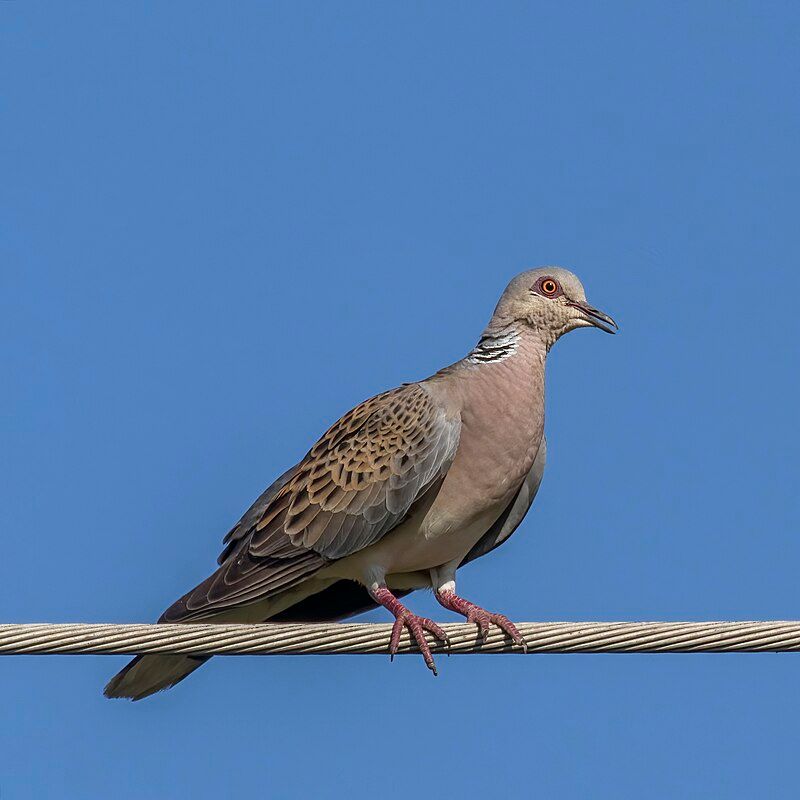
The European turtle dove is a species of bird that belongs to the Columbidae family, which includes doves and pigeons.
It is native to the southwestern Palearctic region, which encompasses several countries in Northern Africa and parts of Europe.
It can be found in this area during the breeding season, but it migrates south for the winter months to northern sub-Saharan Africa.
European turtle doves are a fairly common sight in their natural habitats, and their plumage is predominantly grey and brown.
They are small birds, typically measuring no larger than 30 cm long. They primarily feed on seeds and fruits, although they will also eat insects from time to time.
European turtle doves are monogamous and form strong pair bonds with their mate.
During the breeding season, they build a shallow nest out of twigs and grasses and lay two to three eggs. The female incubates the eggs for around two weeks, after which the young hatch. The male helps to feed the young until they are ready to fledge.
European turtle doves are a threatened species due to habitat destruction, intensification of agriculture, and hunting.
In recent years, conservation measures have been implemented to help protect the species, such as establishing protected areas and introducing hunting limits in some areas.
Despite these efforts, the population of European turtle doves is still declining, and much more work needs to be done to ensure their long-term survival.
| Kingdom | Animalia |
| Phylum | Chordata |
| Class | Aves |
| Order | Columbiformes |
| Family | Columbidae |
| Genus | Streptopelia |
| Species | S. turtur |
2. Alpine Swift
The alpine swift is a species of swift found across multiple continents, including Africa, southern Europe, and Asia. This swift species is particularly well adapted to living and breeding in mountainous regions, from southern Europe to the Himalayas.
Alpine swifts are migratory birds, meaning they travel to different parts of the world depending on the season. For example, the southern European population of alpine swifts migrate south to southern Africa during the winter months.
This allows the species to take advantage of different climates and habitats throughout the year. This adaptation ensures the species’ survival and helps maintain its population size.
| Kingdom | Animalia |
| Phylum | Chordata |
| Class | Aves |
| Clade | Strisores |
| Order | Apodiformes |
| Family | Apodidae |
| Genus | Tachymarptis |
| Species | T. melba |
3. Common Swift
The common swift is a medium-sized bird that is similar in appearance to the barn swallow and house martin but is slightly larger. It does not belong to the same family as those two species; it is a member of the order Apodiformes.
The similarities between the three species are not due to a common ancestor but rather due to convergent evolution. Convergent evolution occurs when two species independently evolve similar traits in response to similar environmental pressures.
In this case, the common swift, barn swallow, and house martin have all adapted to live and thrive in similar environments, resulting in similar physical characteristics.
| Kingdom | Animalia |
| Phylum | Chordata |
| Class | Aves |
| Clade | Strisores |
| Order | Apodiformes |
| Family | Apodidae |
| Genus | Apus |
| Species | A. apus |
4. Pallid Swift
The pallid swift is a type of swift, a small, migratory bird. The scientific name for this species is Apus pallidus, which comes from Latin origins. The genus name Apus is Latin for a swift, and the species name pallidus means “pale”.
Swifts have unique characteristics that set them apart from other birds, such as their short legs for clinging to vertical surfaces. They are also unable to land on the ground voluntarily.
This species is migratory, meaning it will migrate between different areas to breed. The pallid swift is particularly adapted for life in the air and has long, pointed wings, allowing it to cover large distances quickly.
These swifts are also notable for their pale coloring, which provides camouflage from predators. They can be found in many parts of the world, from Africa to Europe and Asia.
The pallid swift is an important species in the avian world, as it helps to keep the populations of other bird species in check.
| Kingdom | Animalia |
| Phylum | Chordata |
| Class | Aves |
| Clade | Strisores |
| Order | Apodiformes |
| Family | Apodidae |
| Genus | Apus |
| Species | A. pallidus |
5. Ferruginous Duck
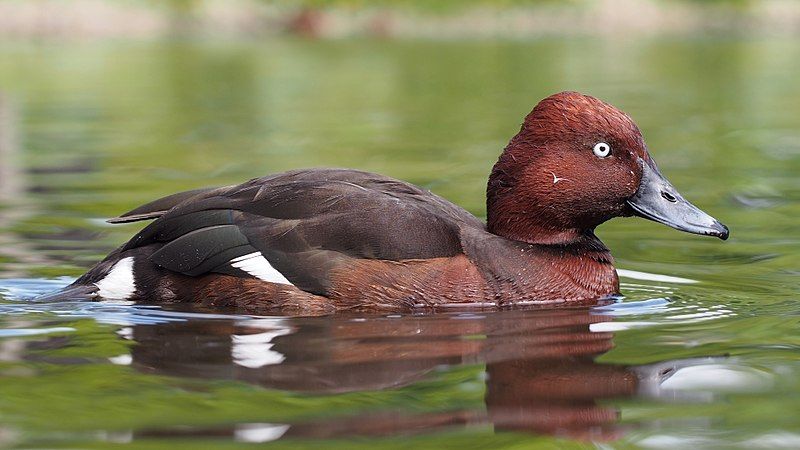
The ferruginous duck is a unique species of diving duck native to Eurosiberia. Several other names, including ferruginous, common white-eye, and white-eyed pochard, also know it.
The species’ scientific name is derived from Greek, with ‘Lithuania’ being an unidentified seabird mentioned by authors such as Hesychius and Aristotle and ‘nyrok’ being the Russian name for a duck.
The ferruginous duck is a medium-sized species that typically grows to around 47 cm in length and can weigh up to 1.3 kg.
The males of the species are typically larger than the females and are easily identifiable thanks to their distinctive rust-colored plumage.
On the other hand, the female ferruginous ducks have brownish-gray feathers with a white patch on the face. The ferruginous duck is a diving duck typically found in shallow wetlands and rivers.
It feeds mainly on aquatic insects, mollusks, crustaceans, and plants.
The ducks typically nest in marshes; the nests are usually well-concealed and well-camouflaged. The ferruginous duck is considered a vulnerable species, with an estimated population of around 30,000 individuals.
The population has been declining in recent years due to habitat loss, degradation, hunting, and poaching. Conservation efforts are underway to try and protect the species and its habitat.
| Kingdom | Animalia |
| Phylum | Chordata |
| Class | Aves |
| Order | Anseriformes |
| Family | Anatidae |
| Genus | Aythya |
| Species | A. nyroca |
6. Eurasian Collared Dove
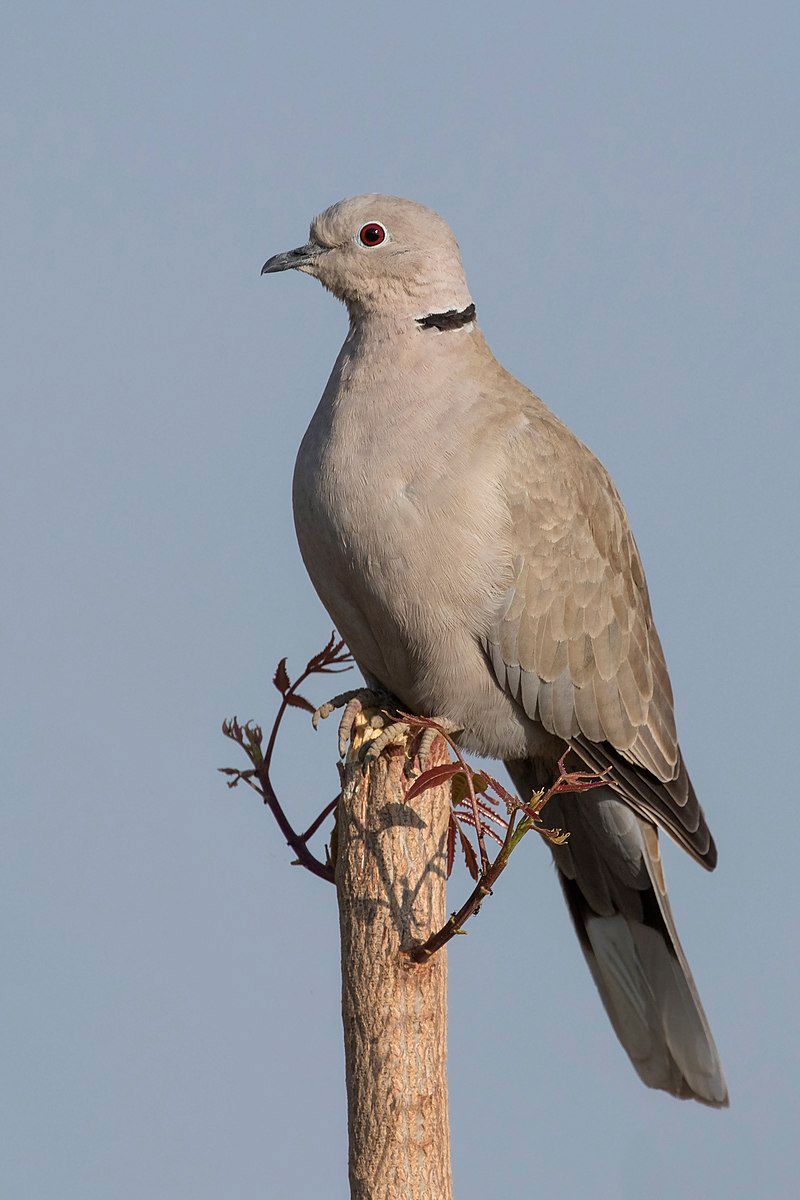
The Eurasian collared dove (Streptopelia decaocto) is a dove species native to Europe and Asia. It is known for its distinctive black collar, which gives the bird its name.
The species was introduced to Japan, North America, and islands in the Caribbean in the late 20th century, likely due to pet release or escape, and has since spread to become a common bird species in these regions.
The Eurasian collared dove is a medium-sized bird, averaging 28 cm long, with a wingspan of up to 40 cm. Its plumage is brownish-grey with a pinkish tinge on its breast. The bird is known for its loud, repetitive cooing calls.
The dove is omnivorous, consisting of grains, seeds, fruits, insects, and occasionally small animals. It prefers open habitats such as fields, pastures, and parks and can often be seen foraging on the ground.
The Eurasian collared dove is a monogamous species and usually breeds in the spring. The female builds a shallow nest from twigs and grass and lays two eggs incubated for about two weeks. The chicks fled the nest a few weeks later.
The Eurasian collared dove is a successful invasive species, and its population is rapidly growing in its introduced range.
| Kingdom | Animalia |
| Phylum | Chordata |
| Class | Aves |
| Order | Columbiformes |
| Family | Columbidae |
| Genus | Streptopelia |
| Species | S. decaocto |
7. Garganey
The garganey is a small species of dabbling duck found in Europe, the Palearctic, Africa, India, Bangladesh, and Australasia. It is a migratory bird, meaning that its population moves around seasonally.
In the Northern Hemisphere, these birds migrate south during the winter to warmer climates. In these more temperate regions, large flocks of garganey can be found. During the summer, the birds move back north to breed.
This seasonal migration pattern helps ensure the garganey population can survive and reproduce, even during difficult winters.
| Kingdom | Animalia |
| Phylum | Chordata |
| Class | Aves |
| Order | Anseriformes |
| Family | Anatidae |
| Genus | Spatula |
| Species | S. querquedula |
8. European Nightjar
The European nightjar is a species of bird from the nightjar family, found across most of Europe, parts of the Palearctic, and as far east as Mongolia and Northwestern China.
This species is crepuscular and nocturnal, meaning it is most active during the twilight hours of dawn and dusk.
The bird is also known as the common goatucker, Eurasian nightjar, or simply nightjar. The European nightjar is a slender bird, typically measuring around 25 centimeters in length with a wingspan of up to 75 centimeters.
The body is brown, with black, grey, and white markings on the wings and tail. It also has a distinctive white band across its forehead and a white throat.
The European nightjar has long wings and a short tail, which it uses to glide in search of food. The European nightjar is mainly insectivorous, preying on insects such as moths and beetles.
During breeding, the males perform a unique display flight to attract potential mates.
They will fly up to heights of around 50 meters before hovering and then swooping down in a spiral. The European nightjar is a migratory species, with most birds leaving Europe in the autumn and winter to spend the colder months in Africa.
They return to Europe to breed and raise their young in spring and summer. The European nightjar is considered Least Concern by the International Union for Conservation of Nature. However, its population is declining in some areas.
| Kingdom | Animalia |
| Phylum | Chordata |
| Class | Aves |
| Clade | Strisores |
| Order | Caprimulgiformes |
| Family | Caprimulgidae |
| Genus | Caprimulgus |
| Species | C. europaeus |
9. Cuculus Canorus
The common cuckoo is a bird that belongs to the Cuculiformes order, which includes species like the roadrunners, the anis, and the coucals. This order is known for its members’ habit of laying eggs in other birds’ nests.
The common cuckoo is a migratory species, meaning that it spends the summer months in Europe and Asia and then migrates south for the winter months to Africa. This species is quite widespread, as its range covers much of the globe.
The common cuckoo is an interesting bird, as it has adapted to its migratory lifestyle to survive. It can adjust its behavior and physiology to accommodate the seasonal climate changes.
Additionally, the common cuckoo also has an elaborate mating system, which involves males performing a courtship ritual to attract potential mates.
| Kingdom | Animalia |
| Phylum | Chordata |
| Class | Aves |
| Order | Cuculiformes |
| Family | Cuculidae |
| Genus | Cuculus |
| Species | C. canorus |
10. Great Crested Grebe
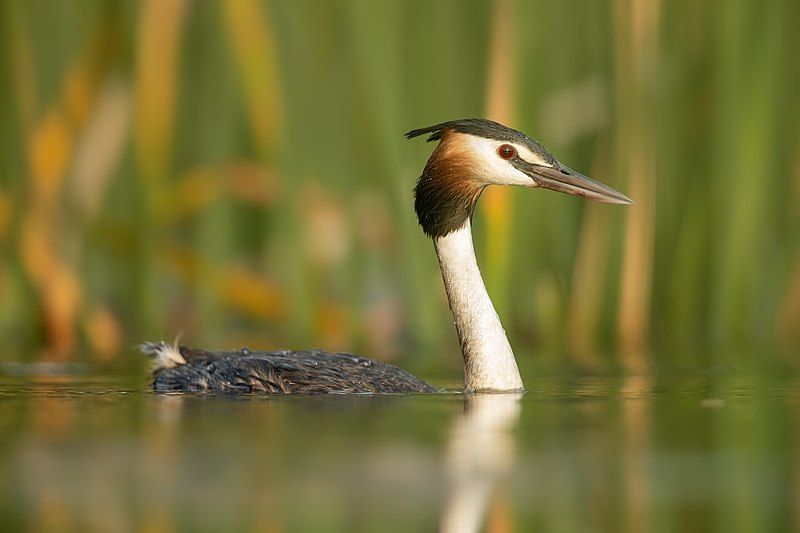
The great crested grebe (Podiceps cristatus) is a water bird native to Eurasia and North America. It is easily recognizable by its distinctive black and white plumage.
It is a member of the Grebe family, which includes about 21 species of freshwater birds.
The great crested grebe is renowned for its elaborate courtship display, which involves the birds making a series of synchronized movements and vocalizations.
The male grebe will perform a head-shaking dance during this display while the female watches.
This display is often accompanied by the male emitting a loud “honking” noise. After the performance, the couple will typically swim together before beginning to nest.
The great crested grebe is a monogamous species, meaning the same pair will mate yearly for as long as they are both alive. These birds are also very territorial, with the male guarding its territory from intruders.
The great crested grebe is an important species in many ecosystems, as it consumes a variety of aquatic organisms and helps keep the water clean.
| Kingdom | Animalia |
| Phylum | Chordata |
| Class | Aves |
| Order | Podicipediformes |
| Family | Podicipedidae |
| Genus | Podiceps |
| Species | P. cristatus |
11. Marbled Duck
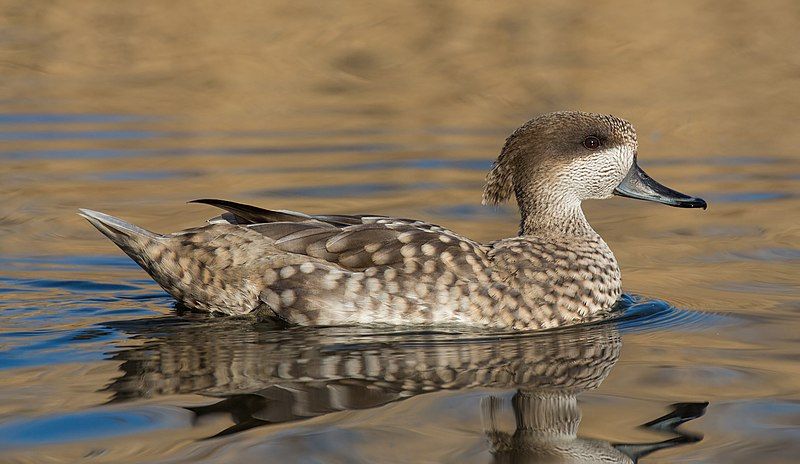
The marbled duck, also known as the marbled teal, is a species native to southern Europe, northern Africa, and western and central Asia. It is a medium-sized duck with a body length of about 56 cm.
The scientific name for this species is Marmaronetta angustirostris, which refers to its feathers’ unique marbled pattern and narrow bill.
The name is derived from the Greek Marmaris, meaning “marbled,” and Netta, meaning “duck,” and the Latin Augustus, which means “narrow” or “small,” and rosters, which means “billed.”
This species has a long and narrow bill, which helps it feed on small aquatic creatures such as mollusks and insects.
The marbled duck is a fairly common species, often forming small flocks while feeding.
| Kingdom | Animalia |
| Phylum | Chordata |
| Class | Aves |
| Order | Anseriformes |
| Family | Anatidae |
| Genus | Marmaronetta |
| Species | M. angustirostris |
12. Eurasian Wigeon
The Eurasian wigeon is a species of dabbling duck found in the Palearctic region. It is also sometimes referred to as the European widgeon or simply wigeon. It is one of three species of wigeon that make up the Mareca genus.
The Eurasian wigeon can be found in many parts of its range, which makes it a widespread species. It is a medium-sized duck that has a brown head and white neck.
The male has a green head and gray body, while the female has a dull grey-brown head and body.
The Eurasian wigeon feeds mainly on plants and aquatic invertebrates, although they will also take small fish. They are mostly found in shallow wetlands like marshes, ponds, and lakes.
These ducks typically form flocks during the winter months and can be seen in large numbers.
| Kingdom | Animalia |
| Phylum | Chordata |
| Class | Aves |
| Order | Anseriformes |
| Family | Anatidae |
| Genus | Mareca |
| Species | M. penelope |
13. Gadwall
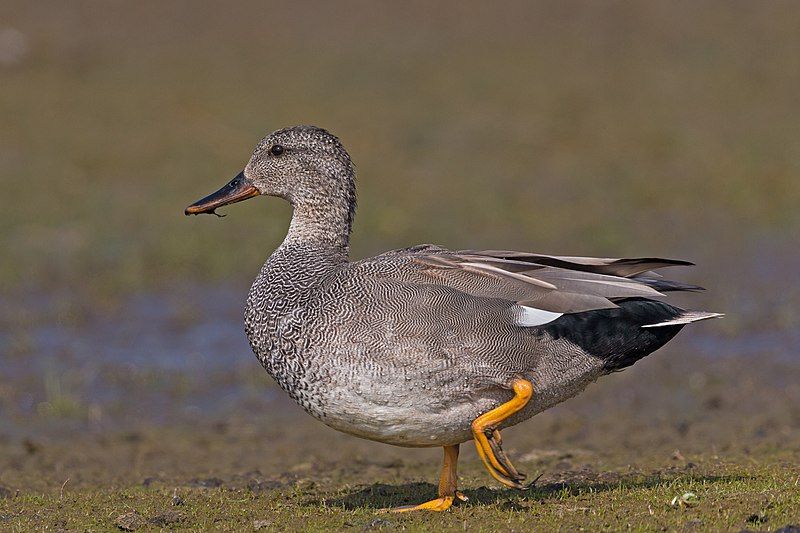
The gadwall is a species of dabbling duck from the Anatidae family. It is a common duck, meaning it can be found in many places worldwide.
It is particularly widespread, meaning it can be found in various habitats, from wetlands to grasslands. This duck species is usually seen in flocks and feeds by dabbling, meaning it will tip its head underwater and search for food with its bill.
It mainly eats aquatic plants, insects, and mollusks. Gadwall ducks are quite large, measuring 19-20 inches long and weighing between 1.6-2.9 lbs.
Males are usually grey and white, while females are dull brown. Gadwall ducks are found in many parts of Europe, and in North America, they breed in Alaska, the Great Lakes region, and the southwestern United States.
They can also be found in Asia, Africa, and South America. In the winter, they migrate to warmer areas, such as Mexico and the Caribbean. Overall, the gadwall is a species of dabbling duck found in many different parts of the world.
It is a widespread species and is an important part of many wetland ecosystems.
| Kingdom | Animalia |
| Phylum | Chordata |
| Class | Aves |
| Order | Anseriformes |
| Family | Anatidae |
| Genus | Mareca |
| Species | M. strepera |
14. Red-Crested Pochard
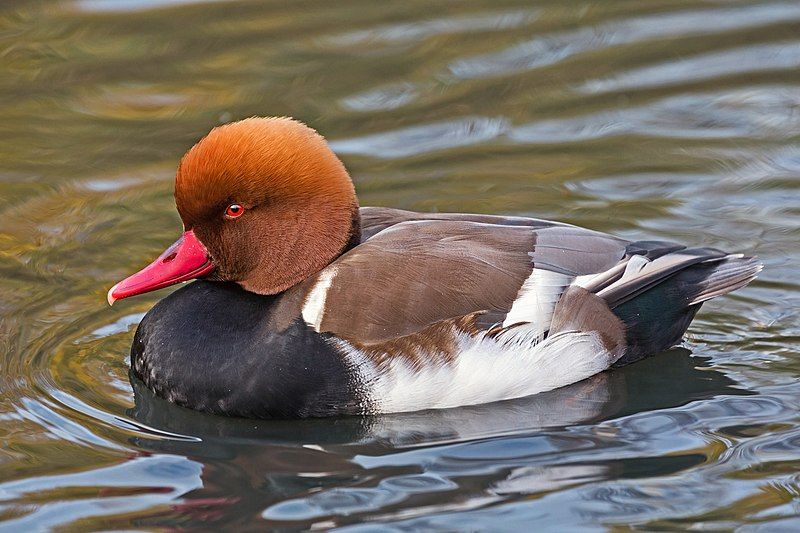
The red-crested pochard is a large species of diving duck native to Europe and Asia. Its unique coloring distinguishes it: golden-red on the head and neck and black on the body, wings, and tail.
The scientific name of this species, Netta rufina, is derived from two ancient Greek words: Netta, meaning “duck”, and rufina, meaning “golden-red”. This reflects the red-crested pochard’s characteristic red-gold crest, which is this species’s distinguishing feature.
The red-crested pochard is a popular bird among birdwatchers and other nature enthusiasts. It is a strong and agile swimmer, often seen in large flocks on ponds and lakes. It feeds mostly on aquatic vegetation but also eats crustaceans and insects.
The red-crested pochard is a migratory species, breeding in the summer and migrating south in the winter. The red-crested pochard is an important species in the wetland habitat and is listed as a species of Least Concern by the IUCN.
It faces threats from hunting, agricultural intensification, and wetland destruction. Conservation efforts are necessary to ensure the future of this species.
| Kingdom | Animalia |
| Phylum | Chordata |
| Class | Aves |
| Order | Anseriformes |
| Family | Anatidae |
| Genus | Netta |
| Species | N. rufina |
15. Rock Partridge
The rock partridge, also known as the common rock partridge, is a type of gamebird that belongs to the Phasianidae family and the Galliformes order.
It is native to southern Europe and is closely related to the chukar partridge, A. chukar, its eastern equivalent.
The rock partridge is very similar to the chukar partridge in appearance, but certain differences can be observed when they are compared side by side.
The rock partridge is a medium-sized bird with a rounded body, a short tail, and long legs.
It has a mottled brown, white, and black plumage with a white throat, a brown head, and a dark band along the lower back.
The chukar partridge has a similar plumage, but the head is more reddish-brown, and the band along the lower back is more distinct and darker.
Both species have short, pointed wings and short legs. The rock partridge is an omnivorous bird that feeds mainly on seeds, insects, and fruits. It is a ground-dwelling species and is mainly found in rocky areas.
The Chukar partridge is also an omnivorous bird with a diet and habitat similar to the rock partridge. Both species are hunted as gamebirds and are popular with hunters.
| Kingdom | Animalia |
| Phylum | Chordata |
| Class | Aves |
| Order | Galliformes |
| Family | Phasianidae |
| Genus | Alectoris |
| Species | A. graeca |
16. Common Shelduck
The common shelduck is a species of waterfowl belonging to the Tadorna genus. It is widely distributed and common in the Euro-Siberian region of the Palearctic, which encompasses a large geographical area.
It breeds mainly in temperate climates and winters in subtropical regions. During the winter months, the common shelduck can also be found in the Maghreb region in North Africa.
The shelduck is an important species in the region and a vital part of the local ecosystems. It is a highly adaptable species that can move between different habitats to survive.
The common shelduck is an important indicator of the local environment’s health, as its presence is a sign of a healthy, diverse ecosystem.
| Kingdom | Animalia |
| Phylum | Chordata |
| Class | Aves |
| Order | Anseriformes |
| Family | Anatidae |
| Genus | Tadorna |
| Species | T. tadorna |
17. Yelkouan Shearwater
The yelkouan shearwater is a seabird belonging to the Procellariidae family, commonly found in the Mediterranean region.
It is a medium-sized shearwater with a wingspan of up to 45 cm. It has a dark brown back, a whitish underside, and a bright yellow bill.
This species is also known as the Levantine shearwater or Mediterranean shearwater. Historically, the yelkouan shearwater was considered a subspecies of the Manx shearwater. However, recent studies have identified it as a distinct species in its own right.
The two species have a similar appearance but differ in their behavior and habitat preferences.
While the Manx shearwater is a pelagic species and prefers open ocean habitats, the yelkouan shearwater is a coastal species usually found in the waters around the Mediterranean Sea.
The yelkouan shearwater breeds in colonies on rocky islands across the Mediterranean, including the Balearic Islands, the Aegean Sea, and the Adriatic Sea. Its diet consists mostly of small fish, crustaceans, and other marine invertebrates.
Like other seabirds, it is vulnerable to oil spills, fishing nets, and other human activities threatening its breeding and feeding grounds.
Overall, the yelkouan shearwater is an important species in the Mediterranean region, and its habitat and food sources must be protected and preserved.
| Kingdom | Animalia |
| Phylum | Chordata |
| Class | Aves |
| Order | Procellariiformes |
| Family | Procellariidae |
| Genus | Puffinus |
| Species | P. yelkouan |
18. Water Rail
The water rail is a species of the rail family, Rallidae. It is found in Europe, Asia, and North Africa, inhabiting well-vegetated wetlands.
Populations in the northern and eastern parts of its range are migratory, but those found in the warmer regions of its range are permanent residents. The water rail is a secretive bird that prefers to remain hidden in dense vegetation to avoid predators.
It feeds on insects, worms, and other small creatures living in and around the wetland environment. The water rail nests in dense vegetation on the ground and is well camouflaged, making it difficult to spot.
It is also an excellent swimmer, making it well-adapted to its wetland habitat.
| Kingdom | Animalia |
| Phylum | Chordata |
| Class | Aves |
| Order | Gruiformes |
| Family | Rallidae |
| Genus | Rallus |
| Species | R. aquaticus |
19. Common Scoter
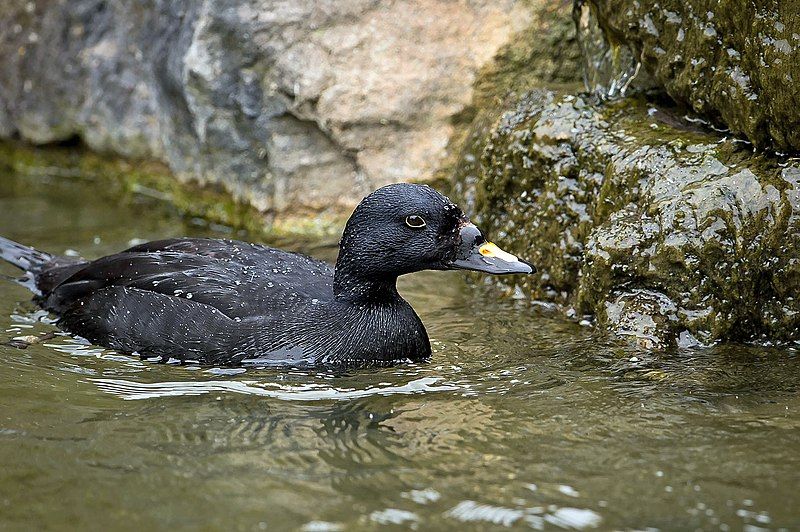
The Common Scoter is a sea duck species in the far north of Europe and the Palearctic east of the Olenyok River. Its body length ranges from 43 to 54 cm, making it a fairly large duck.
The scientific name for this species is derived from the Ancient Greek words melas meaning ‘black’ and netta meaning ‘duck’. Additionally, its species name is derived from Latin niger, meaning ‘shining black’.
This description accurately reflects the physical description of the Common Scoter, which has a black, glossy plumage. The Common Scoter is a migratory species and can be seen in large flocks during the winter months.
They feed in shallow waters, diving for mollusks, crustaceans, and small fish. These ducks are quite social and can be seen in large groups. They are also known to form pairs during the breeding season.
| Kingdom | Animalia |
| Phylum | Chordata |
| Class | Aves |
| Order | Anseriformes |
| Family | Anatidae |
| Genus | Melanitta |
| Species | M. nigra |
20. Greater Flamingo
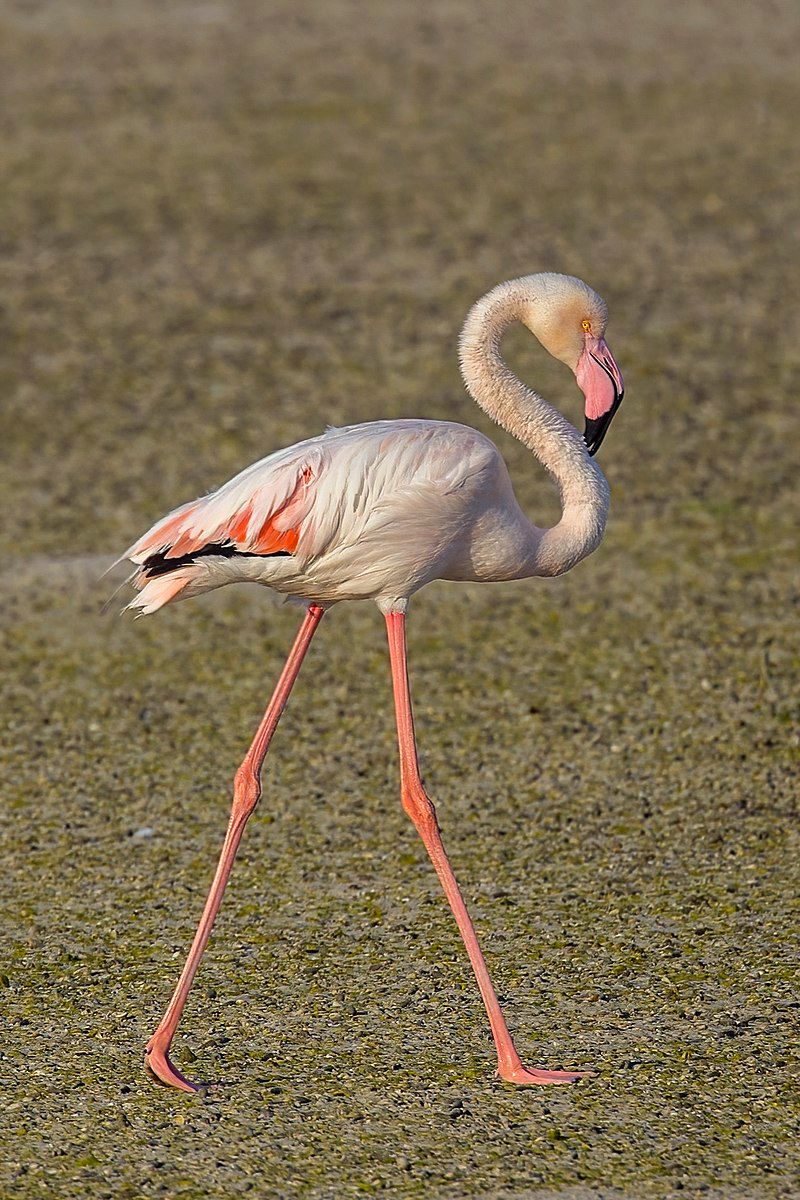
The greater flamingo is a large bird species found throughout a large portion of the Old World.
Native to Northern and Sub-Saharan Africa, they can be seen in the Indian Subcontinent, the Middle East, the Levant, the Persian Gulf, the Gulf of Aden, the Red Sea, and the Mediterranean countries of Southern Europe.
They are the most widespread species of flamingo and are easily distinguishable due to their size and bright pink feathers. These elegant birds inhabit areas with shallow lagoons and salty lakes and have been known to travel great distances in search of food.
It is not uncommon to see large groups of flamingos congregate in these areas, with numbers reaching up to tens of thousands. In addition to their bright plumage, these birds also have specialized filter-feeding bills that they use to consume food from the water.
With their long legs and wingspan, they can fly easily and gracefully. The greater flamingo is an impressive species that is easily recognizable and a sight to behold.
Its large population and wide range make it an important species in the Old World, and its beauty adds a breathtaking element to the landscape.
| Kingdom | Animalia |
| Phylum | Chordata |
| Class | Aves |
| Order | Phoenicopteriformes |
| Family | Phoenicopteridae |
| Genus | Phoenicopterus |
| Species | P. roseus |
21. Scopoli’s Shearwater
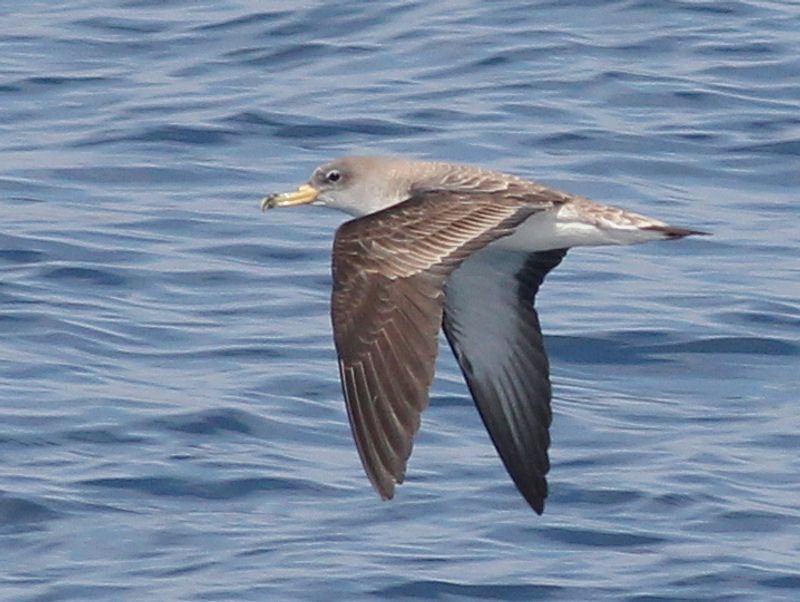
Scopoli’s shearwater is a species of seabird in the petrel family Procellariidae. It has a unique habitat, breeding on rocky islands and steep coasts in the Mediterranean. During the non-breeding season, it migrates to the Atlantic to forage.
Its plumage is mostly brownish grey on its back and wings, with a white underside. This species is a strong flier, and it is known for its long-distance migrations. Its wingspan can be up to 77 cm, typically weighing between 190 to 220 grams.
Its diet consists mostly of small fish, squid, and crustaceans. Scopoli’s shearwater is a unique species with its distinct behavior and habits.
| Kingdom | Animalia |
| Phylum | Chordata |
| Class | Aves |
| Order | Procellariiformes |
| Family | Procellariidae |
| Genus | Calonectris |
| Species | C. diomedea |
22. White Stork
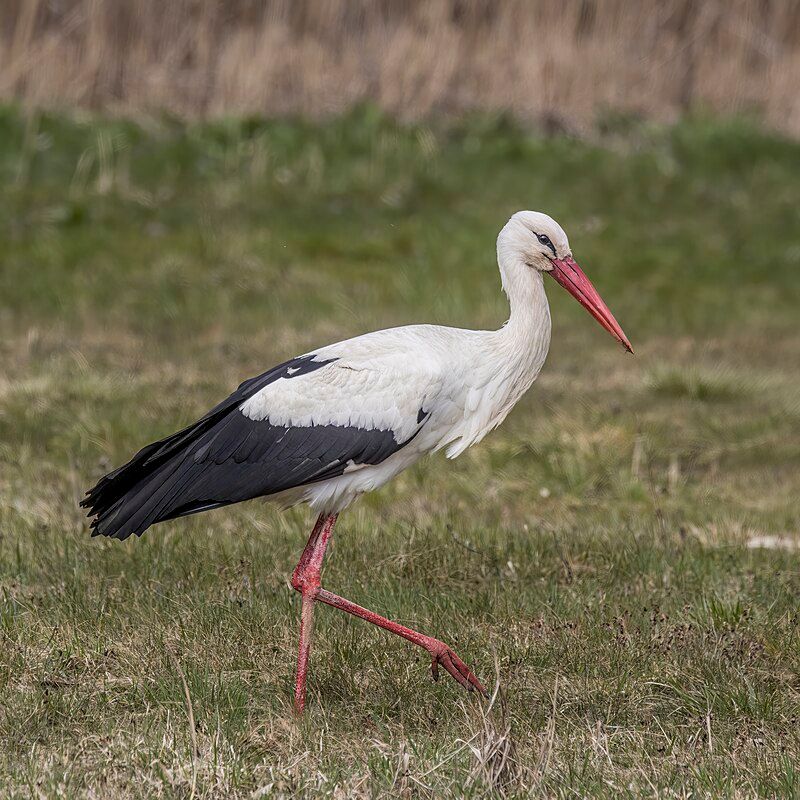
The white stork is a majestic bird belonging to the Ciconiidae family. It stands out from other species due to its distinct white plumage, contrasted by the black feathers on its wings.
It is a large bird with an average height of 100 to 115 cm from the beak tip to the end of its tail. Its wingspan is even more impressive, measuring an average of 155 to 215 cm. The stork’s vibrant red legs and long, pointed beak add to its striking appearance.
This bird is truly a sight to behold, with its beautiful white feathers and strong, red features.
| Kingdom | Animalia |
| Phylum | Chordata |
| Class | Aves |
| Order | Ciconiiformes |
| Family | Ciconiidae |
| Genus | Ciconia |
| Species | C. ciconia |
23. Horned Grebe
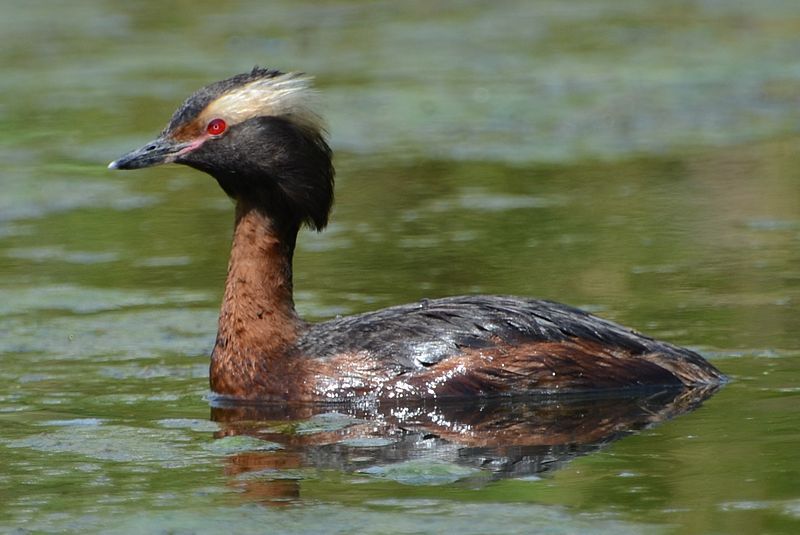
The horned grebe, also known as the Slavonian grebe, is a small species of bird found in the family Podicipedidae. This bird is typically found in wetland habitats and is known for its distinctive horn-like tufts on its head.
There are two subspecies of this species, P. a. auritus and P. a. cornutus. The P. a. auritus subspecies is found in the Palearctic region, which covers Europe, Asia, and parts of North Africa. On the other hand, the P. a. cornutus subspecies is found in North America.
The two subspecies differ in their appearance, with the Palearctic subspecies having a white face, neck, and breast, while the North American subspecies has a greyish face and neck.
Additionally, the North American subspecies has a white patch on the side of its head, while the Palearctic subspecies lacks this feature.
Despite these differences, the two subspecies’ behavior and habitat preferences are very similar.
| Kingdom | Animalia |
| Phylum | Chordata |
| Class | Aves |
| Order | Podicipediformes |
| Family | Podicipedidae |
| Genus | Podiceps |
| Species | P. auritus |
24. White-Headed Duck
The white-headed duck is a small diving bird that measures 45 cm in length. The male of the species is characterized by a white head with a black crown, a blue bill, and reddish-grey feathers.
In contrast, the female white-headed duck has a dark bill and is much duller in color. This duck species prefers to breed in lakes with open water and dense vegetation along the margins.
This vegetation provides an ideal habitat for the white-headed duck, as it provides the perfect cover for nesting and also serves as a food source.
By living in these areas, the duck can remain safe from predators and also have access to the aquatic insects, crustaceans, and other small creatures that they feed on.
The white-headed duck is listed as an endangered species, so protecting its breeding grounds is essential for its survival.
Conservation efforts are needed to ensure these areas remain safe and provide the necessary resources for these birds to thrive.
Such efforts may include limiting human access to the areas, controlling the growth of invasive species, and increasing public awareness of the importance of protecting this unique species.
| Kingdom | Animalia |
| Phylum | Chordata |
| Class | Aves |
| Order | Anseriformes |
| Family | Anatidae |
| Genus | Oxyura |
| Species | O. leucocephala |
Conclusion
Birds of Agrigento are a diverse and fascinating group of creatures. They inhabit various habitats, from the beach to the rural countryside to the urban environment.
Bird watching is a great way to explore the natural beauty of Agrigento and its unique bird species.
By learning more about the birds of Agrigento, we can better appreciate their importance to our local ecosystems and take steps to protect them for future generations.